|
चित्रनिबंध - भारतीय पक्षी (भिगवण) |
|
Birds of Bhigwan |
|
December 2007 |
|
Please use minimum 1280 pixel horizontal screen
resolution for viewing. Please be patient while all the images in
webpage are loaded. |
|
Please do not use the images for any commercial
use without permission. Text in Marathi and English is not exact
translation. |
|
|
|
|
Bhigwan is a small dusty town on the border of Pune and Solapur district in Central Maharashtra, in India. Bhigwan is located on the Pune-Solapur Highway. The distance between Pune city center and Bhigwan is 105 km. One can travel to Bhigwan by various means of transport. How to Reach Bhigwan ? 1) State Transport Buses bound for Solapur and onwards from Pune take you to Bhigwan in 3.5 hours. The obvious advantage of ST bus, is that one need not drive. However Bhigwan is a vast area. The birding spots are as far away as 10 to 15 kms from Bhigwan main town. So this mode is not convenient. There is also a train station at Bhigwan. However both ST bus and train are not convenient.
|
|
2) The personal transport is best way to explore Bhigwan region. The Pune to Solapur road is very busy road with lot of widening work under progress. One needs to drive carefully on this route. Once you reach Bhigwan, Cross the town, and reach the southern end of the town. Drive along NH9, for 8 km beyond Bhigwan towards Solapur,till you reach a village Dalaj no 2. (near Bhadalwadi lake). Here take left and reach the banks of backwaters. Birds can be seen at the backwaters near villages Kumbharwadi, Dalaj. To reach other village called as Diksal, one should start from Bhigwan, take left at the southern end of town, drive along SH68, till you reach Diksal corner. Take right along Kettur Bhigwan road to reach banks of water to see the birds.
|
|
|
| |
|
|
| |
|
|
South of Bhigwan town, exists a widespread backwater formed due to a man made dam built on the Bhima river. The dam is called as Ujni dam. The backwaters is spread over a wide region and is mainly a shallow waste water reserve. There are two areas where one can see the migratory water birds. 1) Diksal-Parewadi area and 2) Dalaj - Kumbharwadi area. To reach Diksal, please reach Solapur end of Bhigwan town. Take left (if you are travelling from Pune) before the River bridge. The road goes to Karmala/ Diksal. Diksal is a small village on this road at distance of 6-7 kms from Bhigwan. Take right from Diksal and travel by road which heads to Bhilarwadi Sugar plant. After the right turn at Dikasal, the road cuts through the backwaters. On both sides of this road one can see backwater and birds. The road is however very narrow. This road has been built on the old railway line. One can see remains of shunting stations and station platforms on this road. Very heavy vehicles are not allowed on the bridge on this road. After travelling for about 4 kms, one reaches, end of the bridge, where fishermen have set up a small roadside village. From here, one can hire a small fishing boat to locate exotic species
|
|
such as flamingo etc.
To reach Dallaj no.2, travel along Solapur highway after Bhigwan for about 9 kms. Take left and further travel for 2 km on rough road. Always remember village names and enquire whenever possible. Native people are friendly. However all the villagers do not understand about the birds and birding locations etc. Most of the villagers in the area are unaware of the importance of ecosystem around them from the point of view of birdlife and migration etc.
There are more than 100 medium or large dams in Maharashra. However, Ujni (bhigwan) is unique. There are no hills around here. Many other maharashtra dams do not host large populations of migratory birds due to very high water depth and clean water. The Ujni backwater is shallow and spread out in vast area. The discharge of water from Pune region dams such as Panshet, Pawna, Khadakwasla, Varasgaon, Temghar, etc flows to Ujni after passing through Pune City. The semiwaste water in this ujni dam backwater area has built very good wetland based ecosystem and helped agriculture also. The rainfall in Pune region decides the water level in Ujani dam. Lesser the water, shallower it is. More birds can be seen in winter. However this causes big problem for resident nesting birds in late summer, due to water scarcity.
|
|
|
|
|
< |
| |
| Rudy Shelduck, Tadorna ferruginea,चक्रवाक,around the wetlands, Ujni backwaters, Bhigwan, Maharashtra, India
|
| |
|
|
रुडी शेलडक किंवा ब्राह्मिणी डक अशा नावांनी ओळखल्या जाणाऱ्या या तपकिरी भगव्या रंगाच्या बदकांचा वावर हिवाळ्यात सर्व पाणथळ ठिकाणी असतो. हिमालयाच्या उत्तरेकडुन हे पक्षि दक्षिण भारताकडे दर हिवाळ्यात स्थलांतर करतात. नर पक्ष्याला मानेकडे काळी पट्टी असते. मात्र हि पट्टी हिवाळ्यात गायब झालेली दिसते. मराठीत या बदकाला चक्रवाक असे म्हणतात. पाण्यात डुबकी मारुन (डोके खाली, शेपुट वर) हे पक्षी उथळ पाण्यातील पाणवनस्पती, शंख, शिंपले खातात.
|
|
The rudy shelducks or Brahminy ducks are winter visitors to South Asia. These birds breed in Central Asia in summer. During the breeding season, the male birds can be identified by a black collar around its neck. The birds are often seen on the river banks in pairs. When disturbed they honk loudly. The face of the bird is whitish, the body is orange brown colored.
|
|
|
|
|
<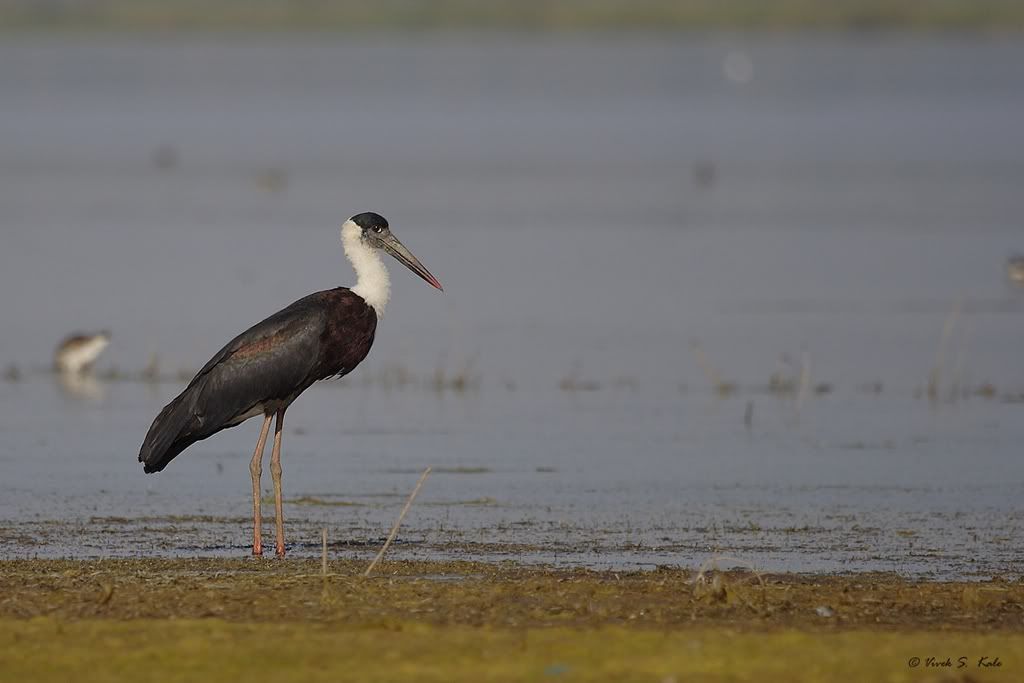 |
| |
| Ciconia episcopus, Wooly Necked Stork,पांढऱ्या मानेचा करकोचा , marshy water body, Ujni backwaters, Bhigwan, Maharashtra, India
|
| |
|
|
पांढऱ्या मानेचा करकोचा आपल्याला शेतात, पाणथळ ठिकाणी हमखास दिसणारा पक्षी आहे. सहसा तो दुकटा अथवा चार-पाच च्या गटात दिसतो. पाणथळ ठिकाणाजवळच झाडावर तो त्याचे घरटे करतो. रंगाने तो दुरुन काळा दिसत असला तरी त्याच्या अंगावर छाती कडे जांभळी चकाकणारी झालर असते. पाठीवर हिरवट काळी चकाकी असते. डोक्यामागे व गळ्यात त्याला सफेद पिसे असतात. लहान वयात हा सफेद झुपका जास्त असतो. वय वाढेल तसा हा सफेद झुपका कमी होतो. पाण्यातले किडे, मासे, बेडुक हे त्याचे प्रमुख खाद्य आहे. त्याचे डोळे बटबटीत जांभळट तांबुस रंगाचे असतात. चोच काळी व टोकाकडे तांबुस असते. पाय लालसर असतात. उंचीस हा पक्षी अंदाजे ८० से.मी. असतो.
|
|
Ciconia episcopus, is a large stork about 80 cm in height. It is a shining black colored bird, with white wooly neck and white belly. The breast and lesser wing coverts are purple glossed. The abdomen is Bronze-green glossed. The plumage is green-blue glossed. Its eyes are large, with crimson iris. Its bill is black with crimson-red at the tip.Its legs and feet are red. The extent of white wool on its neck varies as per its age. The younger birds have more wool than the elder ones. The bird is often seen soaring high in thermals. It is seen in small flocks. It is seen in the marshy area, fields, ponds with trees. The bird is seen in Most of the Indian planes. In Marathi the bird is known as Pandhara Karkocha, for its white woolen neck. The word episcopus means the person who looks at/thinks about something intensely. Epi means intensely and scopus means looks into. The greek word episcopus was used for the bishops in the church. The episcopus used to wear black dress with white cloth around their neck. Hence from this dress, of clerics from the past, for the similarity with the bird avatar, the bird is known as Ciconia episcopus. Ciconia is a genus of birds in the stork family.
|
|
|
|
|
<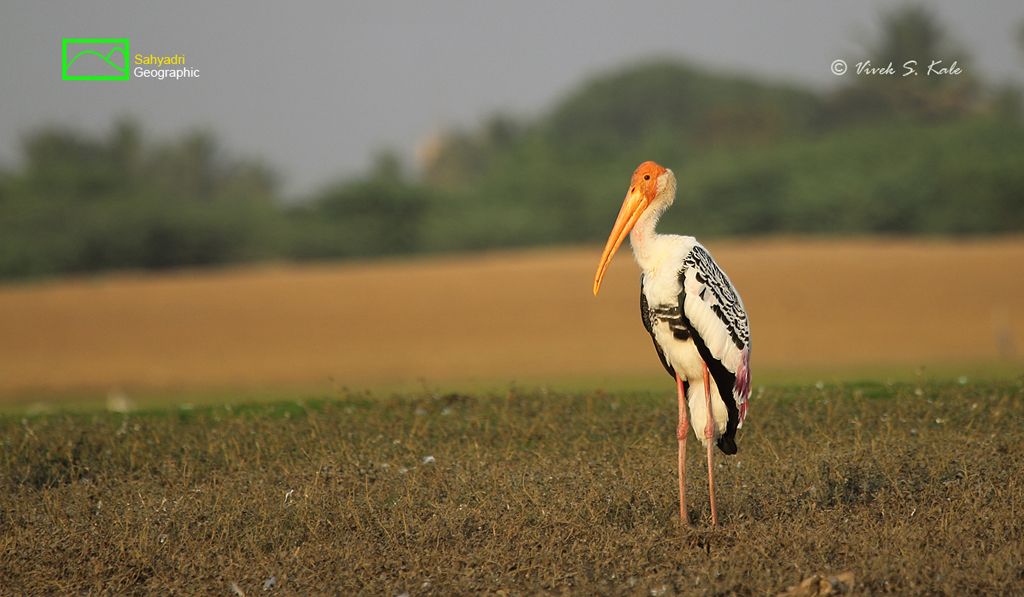 |
| |
| Painted Stork , marshy water body, Ujni backwaters, Bhigwan, Maharashtra, India
|
| |
|
|
|
|
<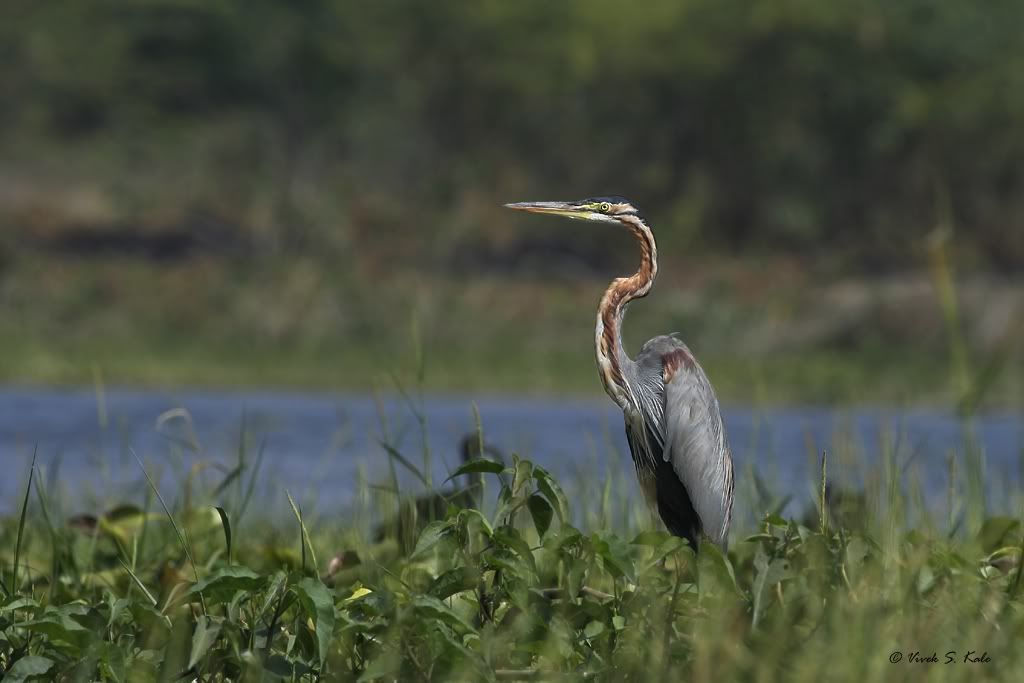 |
| Purple Heron, Ujni backwaters, Bhigwan, Maharashtra, India
|
| Habitat : Wetland, common
|
|
|
|
|
<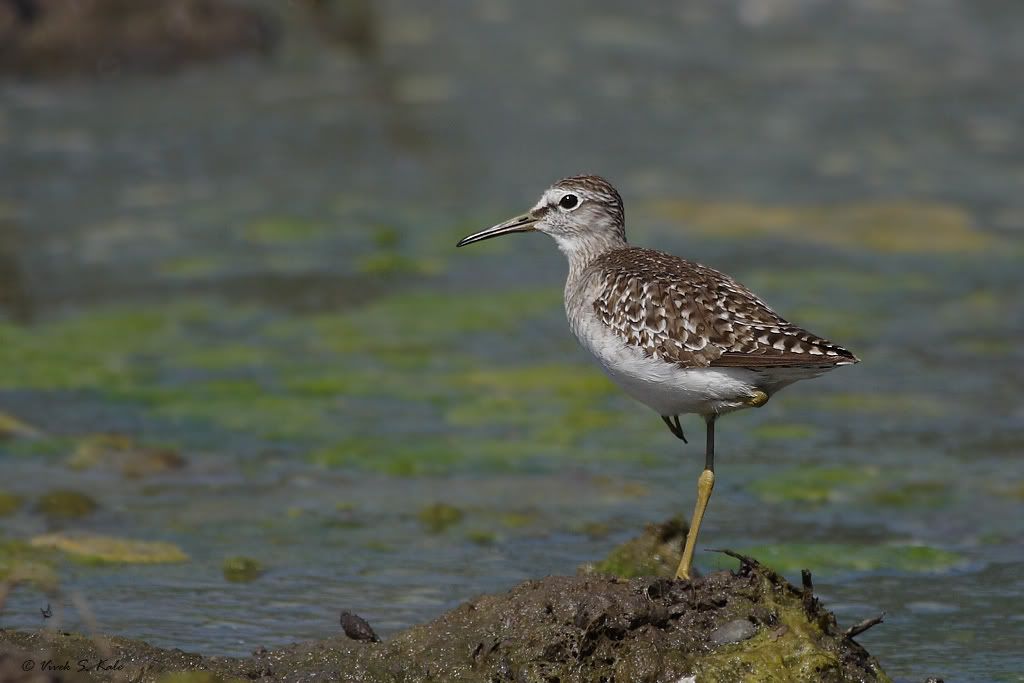 |
| Wood sandpiper, Ujni backwaters, Bhigwan, Maharashtra, India
|
| Habitat : Wetland, common
|
|
|
| |
<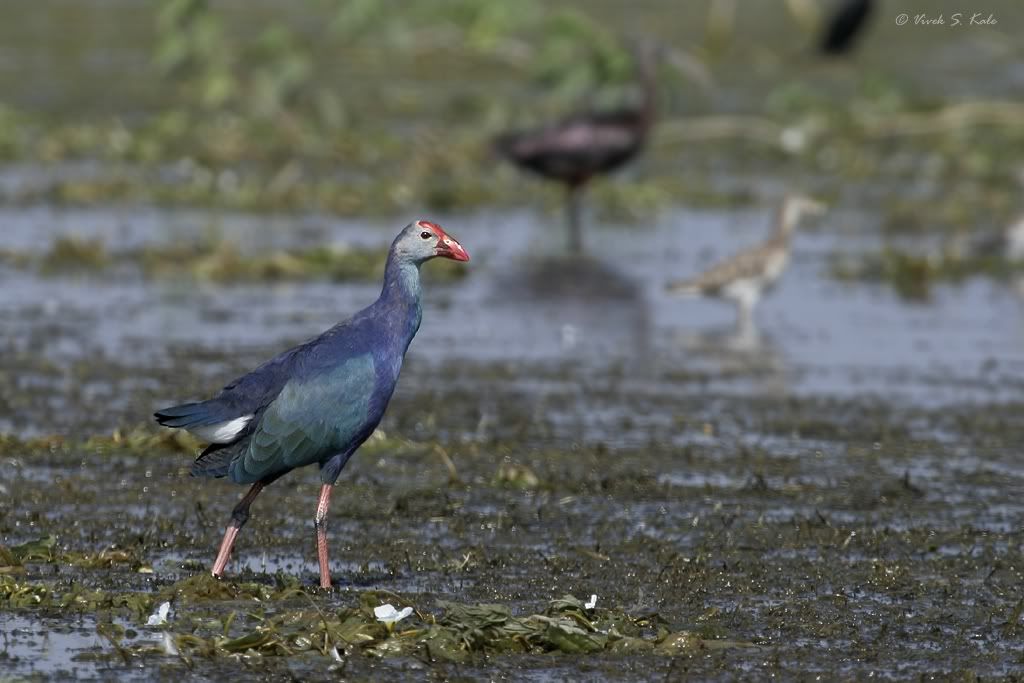 |
| Purple moorhen, Ujni backwaters, Bhigwan, Maharashtra, India
|
| Habitat : Habitat : Wetland, common
|
|
|
|
|
<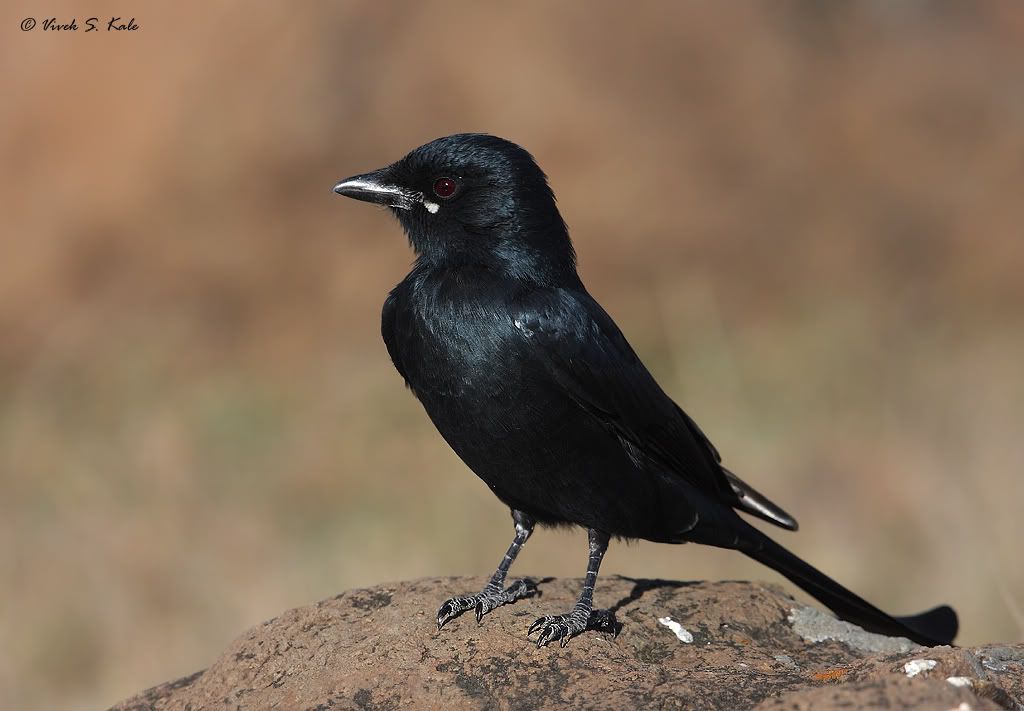 |
| Dicrurus macrocercus, Black Drongo, कोतवाल, Open country, Maharashtra, Pune district
|
| Habitat : Open country, resident
|
|
|
कोतवाल हा एक काळ्या रंगाचा, लाल डोळ्याचा व डोळ्याजवळ सफेद ठिपका असलेला शेतात, गावातील वनराईत हमखास दिसणारा पक्षी होय. झाडाच्या व झुडुपाच्या शेंड़्यावर बसुन राखण करयाच्या त्याच्या प्रवृत्तीमुळे त्याला कोतवाल असे नाव मिळाले आहे. त्याच्या भागात व घरट़्याच्या परिसरात घुसखोरी करणाऱ्या शिकारी पक्ष्यांना हा पक्षी हुसकावतो. नांगरणी झालेल्या शेतात वा तण जाळलेल्या रानमाळावर तो किडे पकडताना हमखास दिसतो. चरणाऱ्या शेळ्यांवर, हरणांवर स्वार होऊन तो चरताना जमिनीतुन बाहेर पडणाऱ्या किड़्यांवर त्याची नजर असते. दुरुन येणाऱ्या श्वापदांवर लक्ष्य ठेवित चरणाऱ्या जनावरास सावध करण्याची त्याला सवय असते. त्यामुळे त्याचे "एकमेका सहाय्य करु" असे या चरणाऱ्या प्राण्यांशी संबंध आहेत असा समज आहे. बरेच लहान पक्षी कोतवालाच्या कोतवालीचा उपयोग करत त्याचा आश्रय घेतात.
|
|
Black drongo, is black in color with dark blue gloss. Its iris is dark crimson brownish, and it has a small white spot near gape. The birds feed on insects mid air and close to ground. The bird perches on prominent perch. In Marathi the bird is known as kotwal meaning a policeman. The bird boldly protects its juveniles and others by fierce fully chasing out the intruders. It is often seen close to the wild fire in the grass/forest. It feeds on the insects coming out of the fire. It is also seen in agricultural land while the farmers plough the field. It has a social understanding with many other grazing animals such as sheeps, dears, cows and buffalos etc. As these animals graze or disturb the ground otherwise, the drongos feed on the insects available due to disturbance in soil. Drongos are often seen perching on such cattle. It is said that the birds pay back to the animals by acting as a Alarm against impending danger to the cattle/dears. The birds fly up and call loudly to raise the alarm. It is a good example of social mutual relationship. It is also known that some species of birds nest close to the nests of drongos to get the protection against the intruders with the help of a strong policebird the drongo. (Call recording link by Andrew Mascarenhas - xeno-canto.org)
|
|
|
|
|
<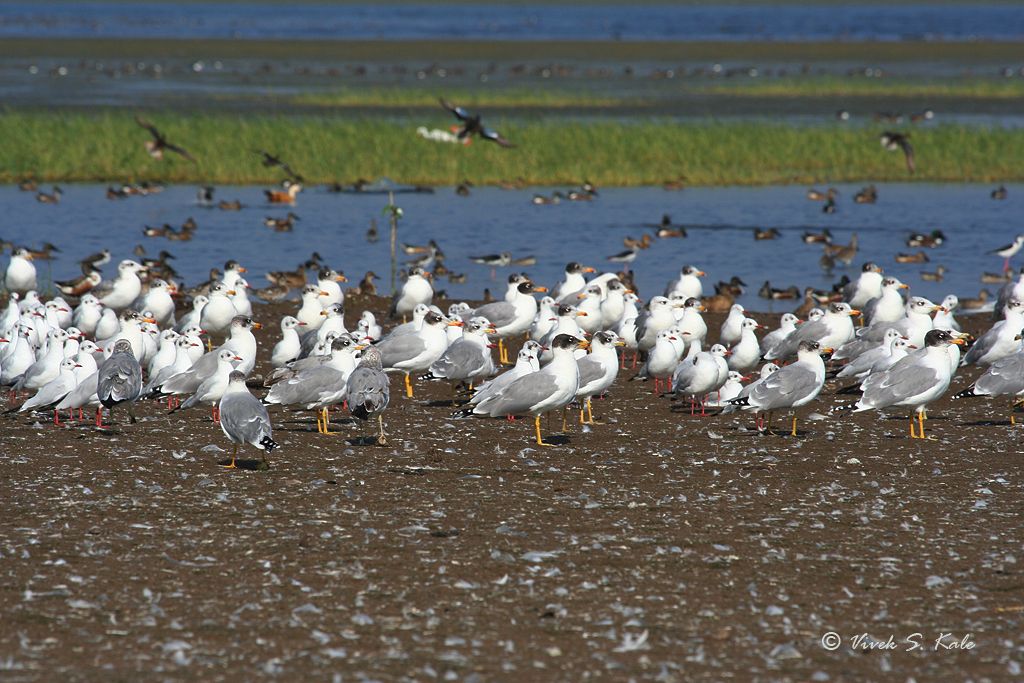 |
| |
| Black headed Gulls and others,around the wetlands, Ujni backwaters, Bhigwan, Maharashtra, India
|
| |
|
|
|
|
< |
| |
| Black headed Gulls and others,around the wetlands, Ujni backwaters, Bhigwan, Maharashtra, India
|
| |
|
|
|
|
<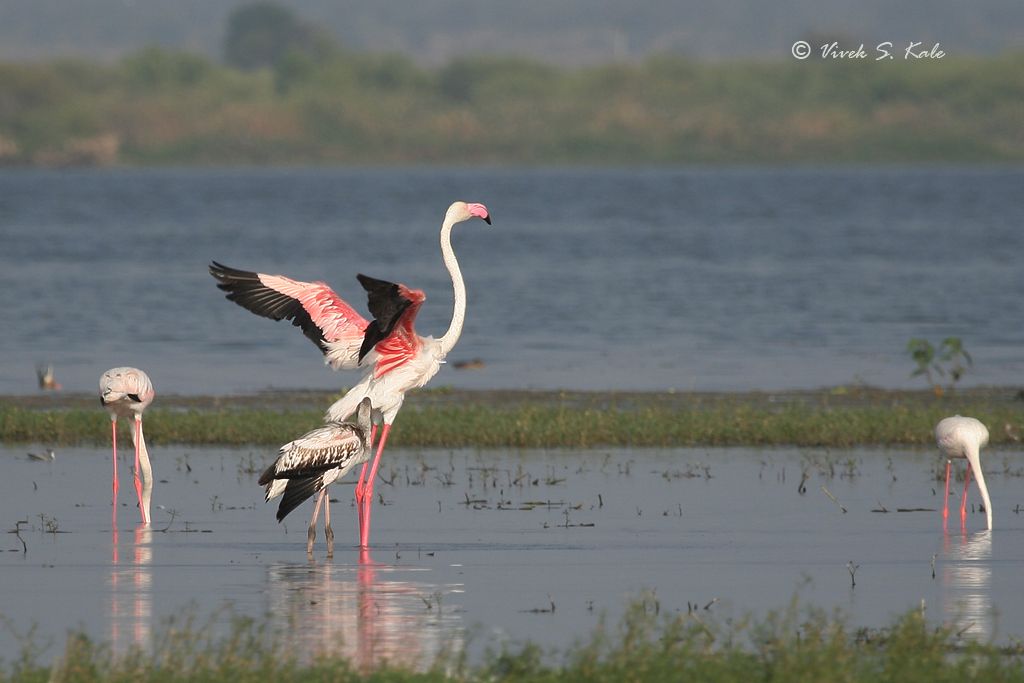 |
| |
| Greater Flamingo,around the wetlands, Ujni backwaters, Bhigwan, Maharashtra, India
|
| |
|
|
|
|
<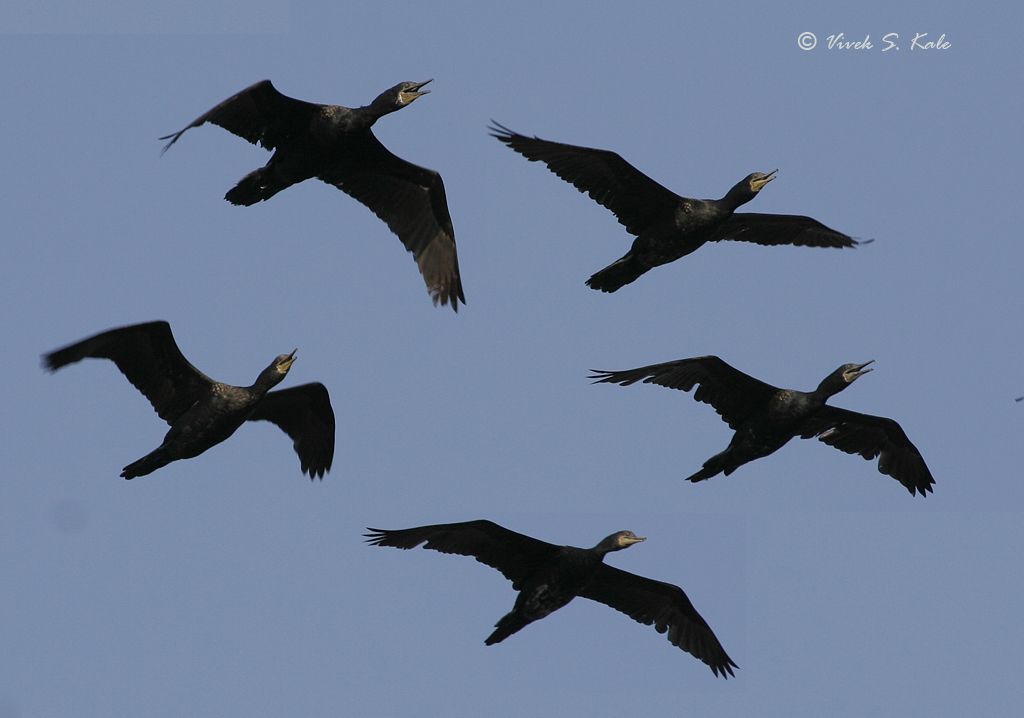 |
| |
| Cormorants,around the wetlands, Ujni backwaters, Bhigwan, Maharashtra, India
|
| |
|
|
|
|
<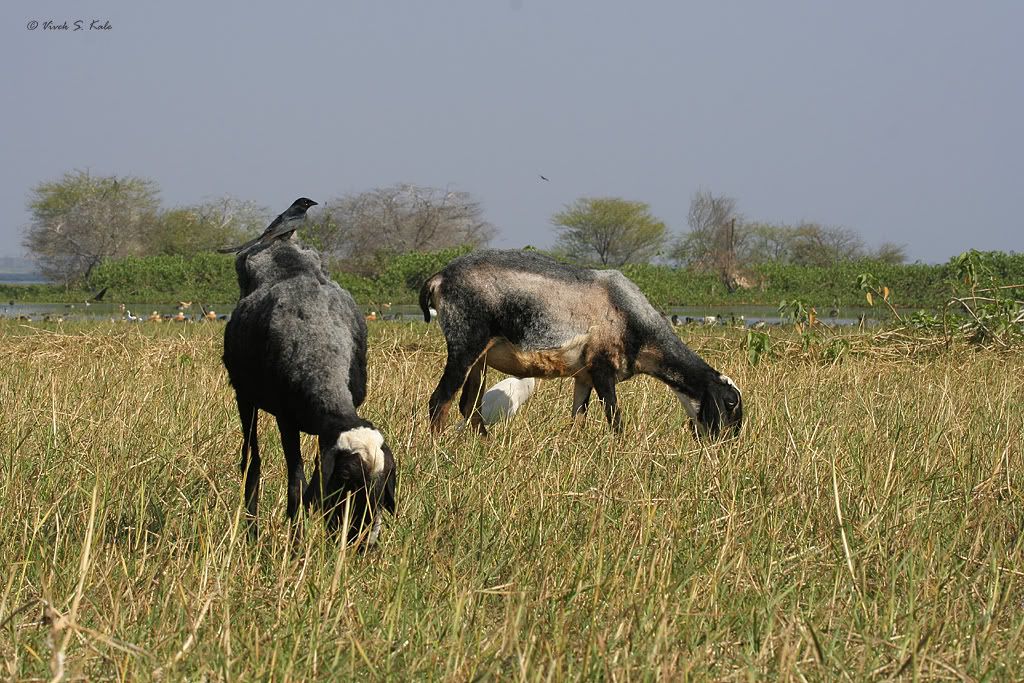 |
| Dicrurus macrocercus, Black Drongo, कोतवाल, Open Country, Maharashtra, Pune district
|
| Habitat : Open country
|
|
|
|
|
<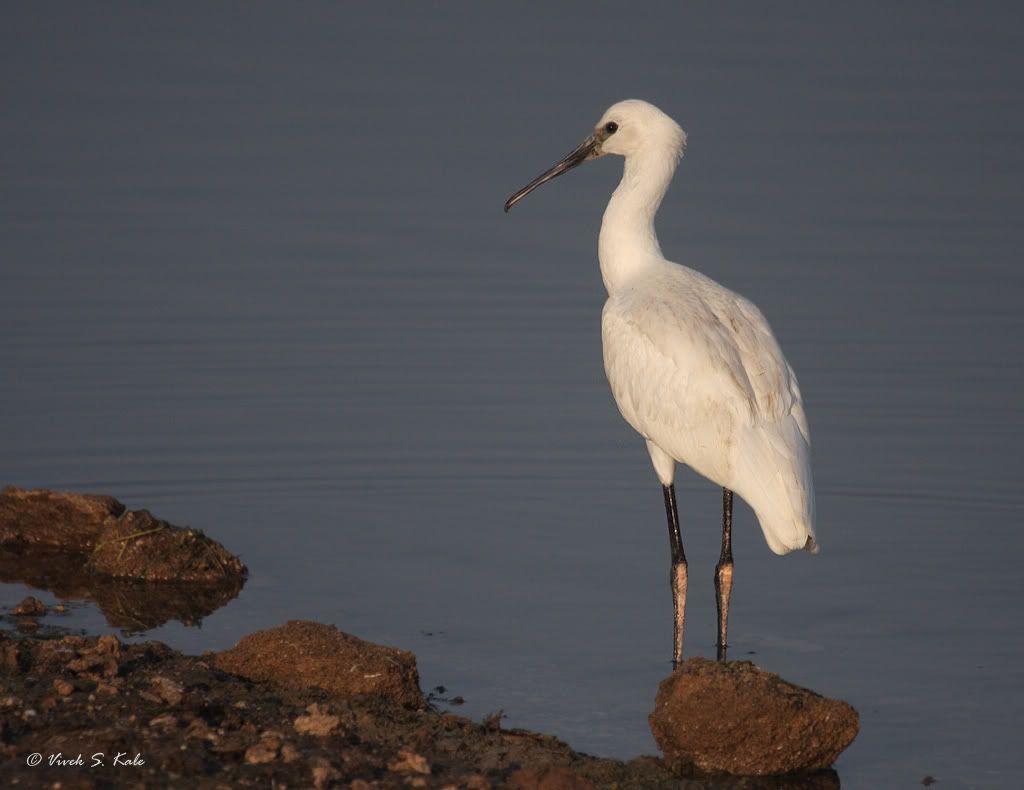 |
| Eurasian spoonbill, चमचा, Habitat : wetland, Maharashtra, Pune district, India
|
| Habitat :Wetland
|
|
|
चमचा म्हणजे युरेशियन स्पुनबिल, हा स्थलांतर करणारा पक्षी आपल्याकडे हिवाळ्यात दिसतो. उन्हाळ्यात तो उत्तरेकडे युरोपात असतो. सफेद रंगाच्या या पक्ष्याची खासियत म्हणजे त्याची चमच्या सारखी चोच. त्याचा वापर तो पाणी ढवळुन मासे पकडण्यासाठी करतो. उथळ पाण्याच्या ठिकाणी तो आढळतो.
|
|
The Eurasian Spoonbill (Platalea leucorodia) is a migratory bird which breeds in Europe in summer and visits South Asia and Africa in winter. It is seen around the shallow fesrh water wetlands. It is mainly a white bird with black legs, dark bill. During the breeding season it has yellow breast patch. The tip of its spoon bill is yellow. The bird uses its spoon bill to stir the water to hunt for fish, aquatic insects.
|
|
|
|
|
< 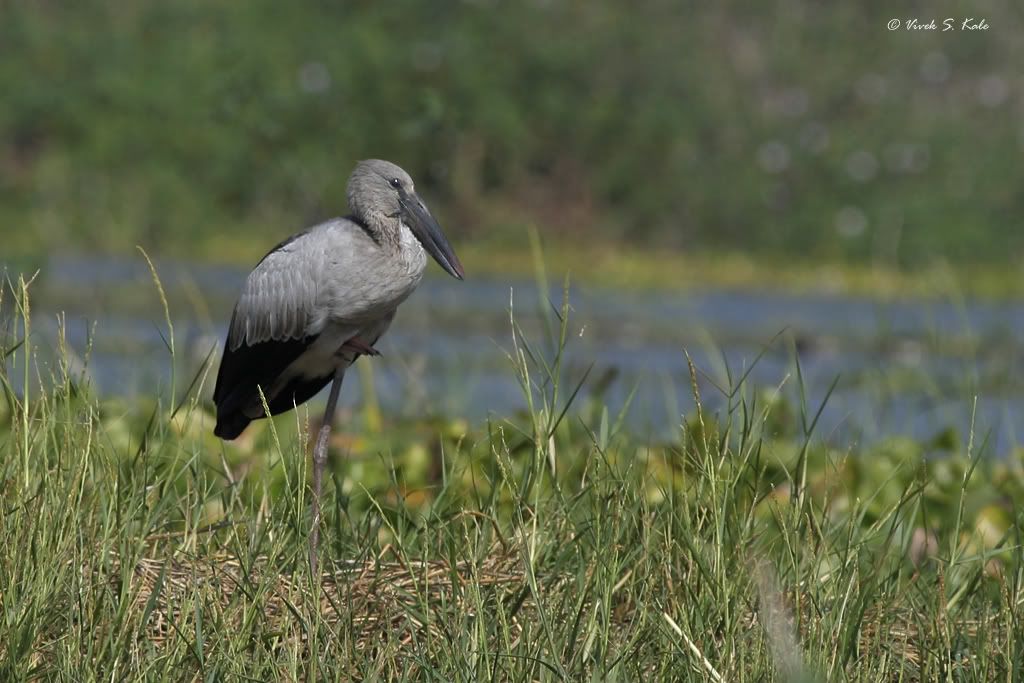 |
| Asian open billed stork, Ujni backwaters, Bhigwan, Maharashtra, India
|
| Habitat : Wetland, common
|
|
|
| |
<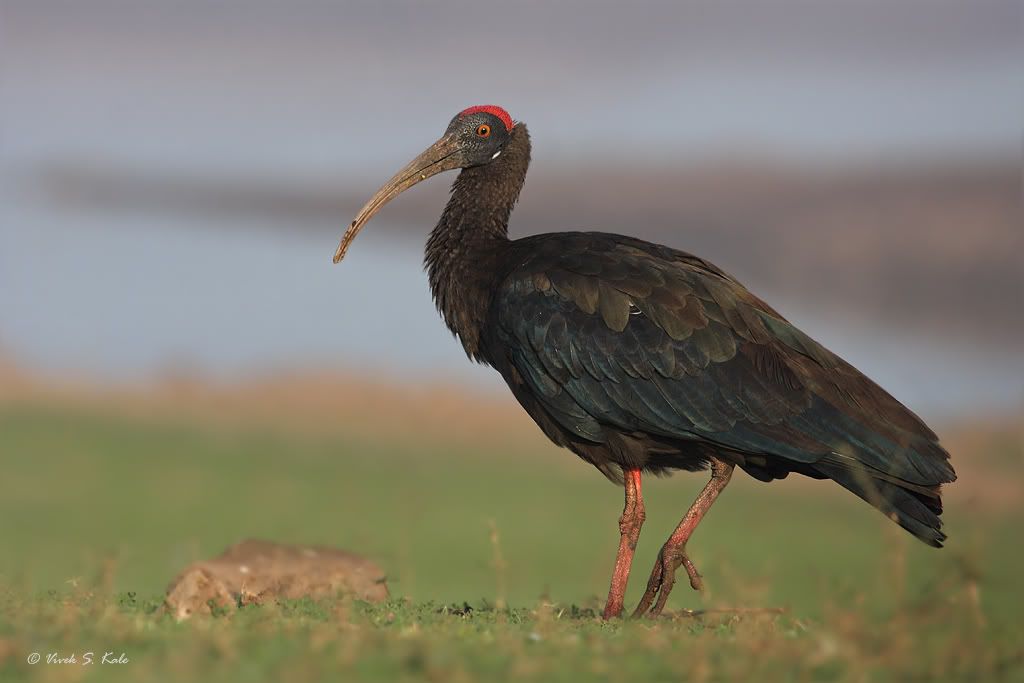 |
| Red-naped Ibis, Pseudibis papillosas, margins around wetland cultivated fields, लाल टोपीवाला शराटी, Maharashtra, Pune district, India
|
| Habitat : margins around wetland cultivated fields
|
|
|
काळा शराटी किंवा लाल टोपीवाला शराटी हा मोठय़ा आकाराचा पक्षि गवताळ जमिनीवर, शेतात किडे
शोधत फिरताना दिसतो. काळसर रंगाच्या या पक्ष्याचे पाय लालसर रंगाचे असतात. डोक्यावर लाल किरमिजी रंगाचा त्रिकोणी चामखिळवजा तुरा असतो. पांढ्ऱ्या शराट्यासारखा हा पाण्याजवळ/पाण्यात नसतो. रात्रीच्या वेळेला हे पक्षि झाडावर विसावतात. घरटी ते झाडावर करतात. रंगाने हा काळा असला तरी, त्याच्या पंखांवर निळसर चकाकी असते. वयाने लहान पक्ष्यांच्या डोक्यावर लाल भागाऐवजी तपकिरि रंगाची लहान पिसे असतात.
|
|
Red-naped Ibis, Pseudibis papillosa is large bird seen all cross Indian planes. Its habitat is mainly the dry cultivated land / and open land around wetlands where it finds lots of insects. Unlike its other sister species like white ibis, this bird is not found inside the wetland/marsh. It rarely wades or feeds on fish. It is always seen grazing in the grass, dry cultivated land looking for insects.
The neck, mantle, lower back, rump and lower plumage is
Brown. The back is bronze-green glossy colored and the tail is
black, richly glossed with blue-green.
There is a conspicuous white patch on the inner lesser wing-coverts.
The rest of wing is black, glossed richly with deep blue or purple-blue.
The eye iris is dull to bright orange-red. The bill is dull green. The head has naked black colored skin with a triangular portion
of brilliant red papillae (warts)covering the skin from a point above the forehead to the back of the nape. The juvenile bird do not have red warts on its head. Instead the young birds have non glossy brown feathers on their head. Its legs and
feet are thick and are brick-red colored.
Though the bird is very silent sometimes it makes a grunting call.
|
|
|
|
|
< 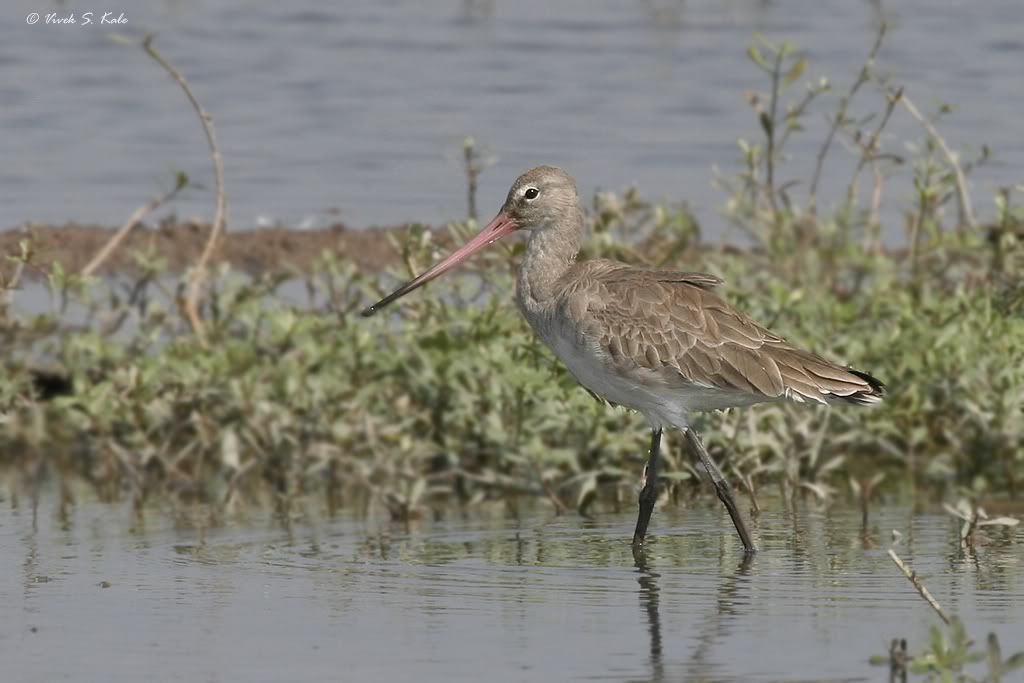 |
| Goodwits, Bhigwan, Maharashtra, India
|
| Habitat : forests in and around hills, uncommon
|
|
|
|
|
< 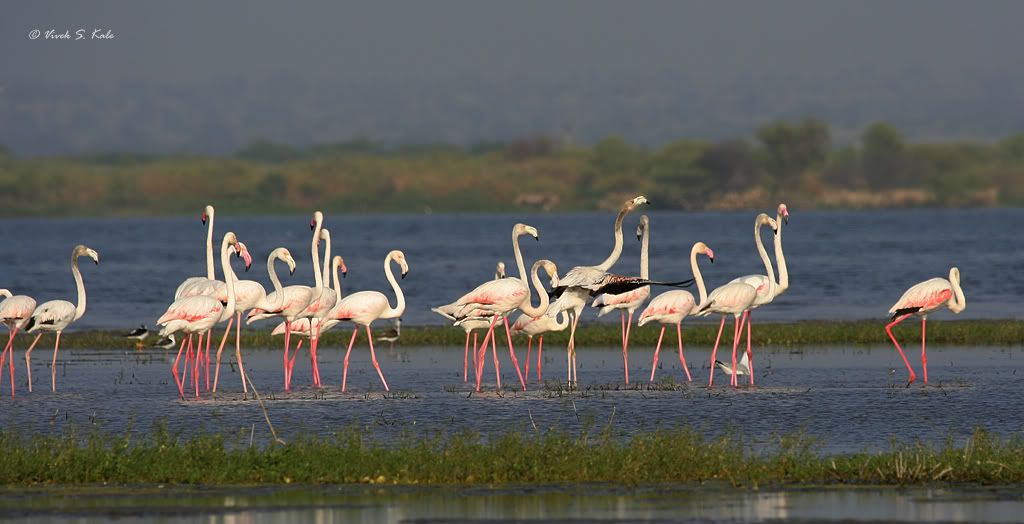 |
| Greater flamingo, Bhigwan, Maharashtra, India
|
| Habitat : Habitat : forests in and around hills, uncommon
|
|
|
| |
<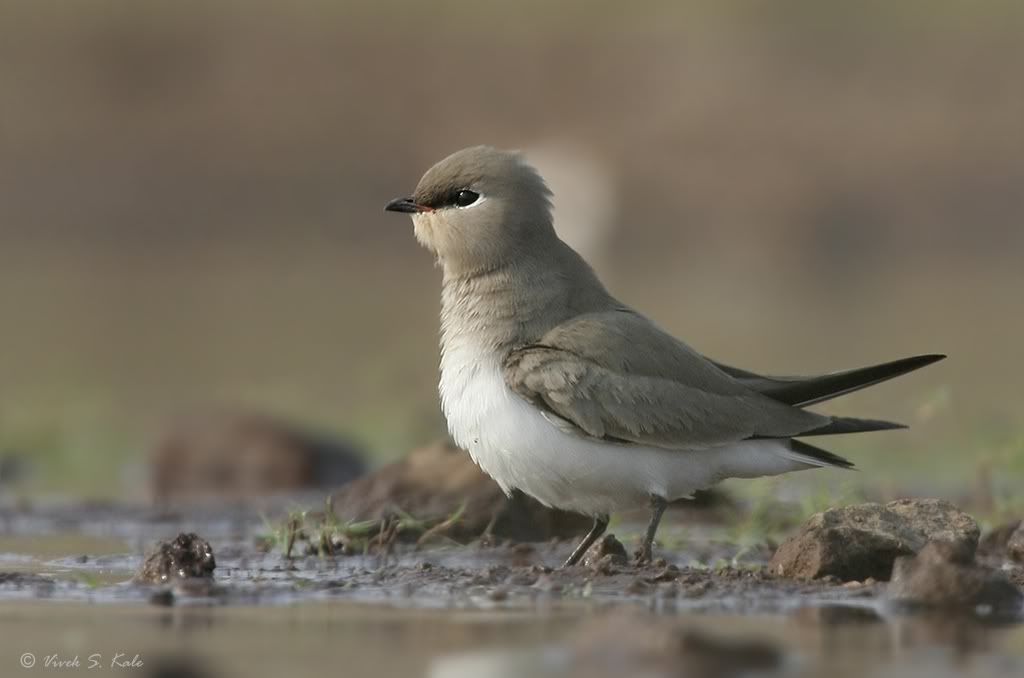 |
| Glareola lactea, Small pratincole, पाणभिंगरी, wetlands and river banks, Maharashtra, Pune district.
|
| Habitat : wetlands and river banks
|
|
|
पाणथळ जागेच्या जवळ दिसणारा हा लहान पक्षी त्याच्या अधिवासाशी जुळत्या राखाडी रंगाचा असल्याने सहज दिसत नाही. लहान पायाचा हा पक्षी हवेत उडताना किडे पकडतो. त्याची शेपुट फोर्कड असते. पोटाकडे तो सफेद असतो. नदी किनारी वाळवंटात तो आपले घरटे घालतो.
|
|
Small Indian Pratincole (Glareola lactea), is a 17 cm, small wader bird . It is a resident bird. In flight the bird looks like swallows.
This bird has short legs, long pointed wings and a short tail. Its short bill is an adaptation to aerial feeding. The crown of the head is brown. The wings are grey above with black primaries and black and white bars at the rear edge of the inner flight feathers. The underwings are mainly black. The forked tail is white with a black terminal triangle. The belly is white. The bird is seen around the water bodies.
(call recording by Arnold Meijer, xeno-canto.org)
|
|
|
| |
<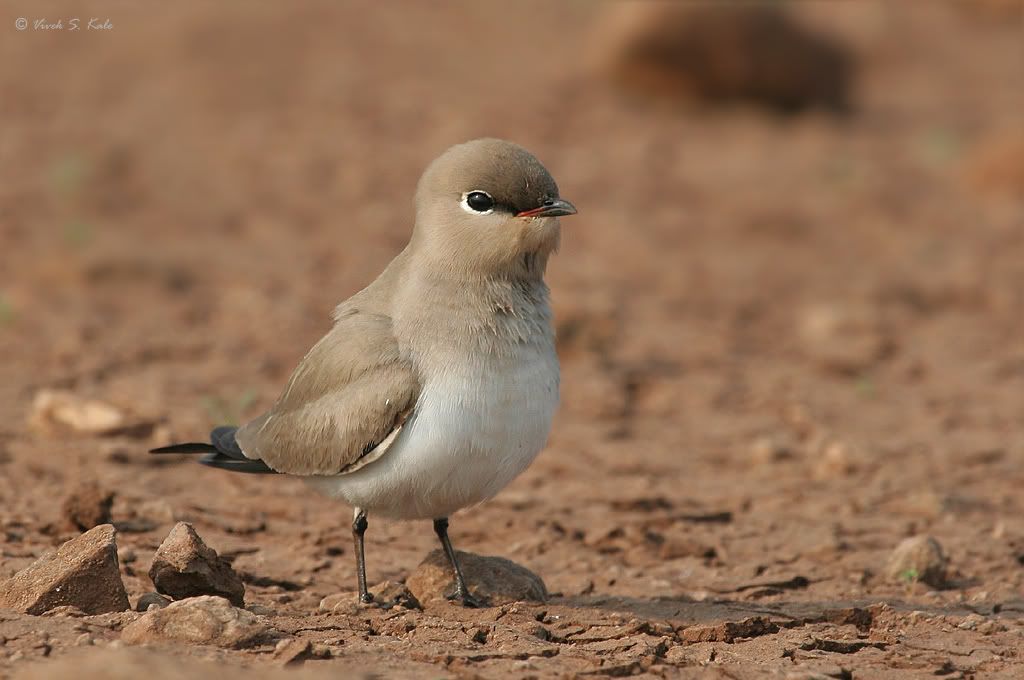 |
| |
| Glareola lactea, Small pratincole, पाणभिंगरी, wetlands and river banks, Maharashtra, Pune district.
|
|
|
<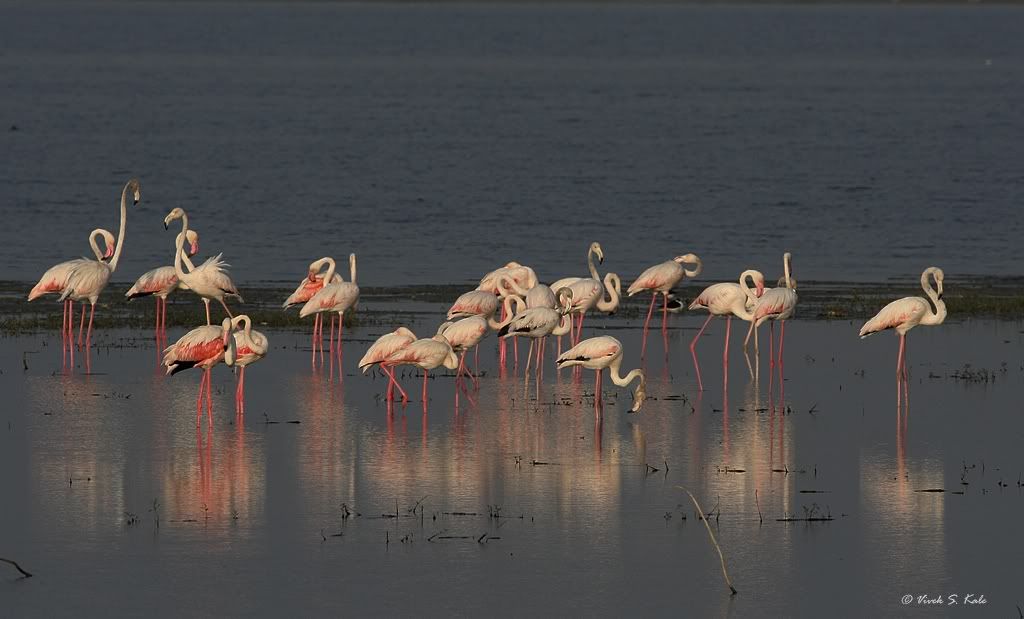 |
| Greater flamingo, Bhigwan, Maharashtra, India
|
| Habitat : Wetland
|
|
|
| <
|
| Athene brama, Spotted Owlet,पिंगळा, Maharashtra, Pune district, October 2007
|
| Habitat : Open country
|
|
|
पिंगळा नावाचे हे लहान घुबड, भारतात सर्वत्र आढळते. झाडांच्या ढोलीत, वडाच्या झाडावर, जुन्या पडक्या विहिरीत, आडवाटेवरच्या खाणीत याचे वास्तव्य असते. याला निरखून पाहिल्यास, हा सुद्धा आपल्याला विदुषकासारखी मान पुढे करुन पाहू लागतो. याचे डोळे पुढे असतात. डोळ्यांचा पिवळा रंग आकर्षक असतो. किडे, उंदिर, छोटे पक्षी हे याचे आवडते खाद्य आहे. याला इंग्रजीत स्पॉटेड ऑवलेट असे संबोधतात. हा जरी निशाचर असला तरी बरेचदा दिवसासुद्धा सतर्क आढळतो.
|
|
The spotted owlets, Athene brama are small owls, which are often seen in a group of 3-4 birds, in open country. These birds roost in tree hollows or rock cavities. These birds hunt small rodents and insects. These birds are grey in color with white spots on its upperparts. The eye iris is yellow. The lower parts of body are streaked and brownish colored. Though mainly nocturnal, they are also active in daytime. (Call by Stuart Fisher, xento-canto.org)
|
|
|
|
|
|
Birds 01 (new) Gallery |
|
Birds 02 (new) Gallery |
|
Contact me at kale_v@rediffmail.com for any queries and
suggestions.
| |


























